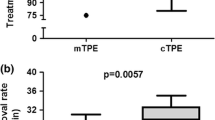Abstract
Online hemodiafiltration (OL-HDF) is a blood purification therapy based on diffusion and ultrafiltration and is classified into two types according to the mode of addition of the substitution fluid: pre-dilution OL-HDF (pre-HDF) and post-dilution OL-HDF (post-HDF); we previously reported that pre-HDF is more biocompatible. However, we used lower blood and substitution flow rates in that study and may not have accurately simulated the treatment conditions used in Europe. In this study, we compared the biocompatibilities of the treatment conditions of pre-HDF, commonly used in Japan, and post-HDF, commonly used in Europe, to determine the most biocompatible treatment conditions. We compared the biocompatibilities of pre-HDF and post-HDF using high blood flow rates and high substitution fluid volumes, and also compared the results with those of our previous study. We enrolled six stable patients undergoing maintenance dialysis at our clinic for this study. After the patients underwent hemodialysis (HD), post-HDF, and pre-HDF treatment, the biocompatibilities (based on the serum levels of high-sensitivity C-reactive protein, interleukin-6, pentraxin-3, β-thromboglobulin, and soluble P-selectin, and the results of the lymphocyte blastogenesis test using phytohemagglutinin and concanavalin A as mitogens) and removal performances (removal performance for urea, creatinine, β2-microglubulin [MG], and α1-MG, and albumin leakage) were determined. There were no significant differences in the biocompatibility parameters evaluated among the three treatment modes. Post-HDF was associated with significantly higher removal rates of β2-MG than HD. Post-HDF was associated with significantly higher removal rate of α1-MG, and also significantly higher albumin leakage, than HD and pre-HDF.




Similar content being viewed by others
References
Kikuchi K, Hamano T, Wada A, Nakai S, Masakane I. Predilution online hemodiafiltration is associated with improved survival compared with hemodialysis. Kidney Int. 2019;95:929–38.
Nitta K, Goto S, Masakane I, Hanafusa N, Taniguchi M, Hasegawa T, Nakai S, Goto S, Wada A, Hamano T, Hoshino J, Joki N, Abe M, Yamamoto K, Nakamoto H. 2018 annual dialysis data report, JSDT renal data registry. J Jpn Soc Dial Ther. 2018;51:699–766 (in Japanese).
Gejyo F, Yamada T, Odani S, Nakagawa Y, Arakawa M, Kunitomo T, Kataoka H, Suzuki M, Hirasawa Y, Shirahama T, Cohen AS. A new form of amyloid protein associated with chronic hemodialysis was identified as beta 2-microglobulin. Biochem Biophys Res Commun. 1985;129:701–6.
Andoh T, Maki T, Li S, Uta D. β2-Microglobulin elicits itch-related responses in mice through the direct activation of primary afferent neurons expressing transient receptor potential vanilloid 1. Eur J Pharmacol. 2017;810:134–40.
Sakurai K. Biomarkers for evaluation of clinical outcomes of hemodiafiltration. Blood Purif. 2013;35:64–8.
Canaud B, Chenine L, Renaud S, Leray H. Optimal therapeutic conditions for online hemodiafiltration. Contrib Nephrol. 2011;168:28–38.
Maduell F, Moreso F, Pons M, Ramos R, Mora-Macià J, Carreras J, Soler J, Torres F, Campistol JM, Martinez-Castelao A, ESOHOL Study Group. High-efficiency postdilution online hemodiafiltration reduces all-cause mortality in hemodialysis patients. J Am Soc Nephrol. 2013;24:487–97.
Kawabata K, Nagake Y, Shikata K, Fukuda S, Nakazono H, Takahashi M, Ichikawa H, Makino H. Soluble P-selectin is released from activated platelets in vivo during hemodialysis. Nephron. 1998;78:148–55.
Ojeda R, Arias-Guillén M, Gómez M, Vera M, Fontseré N, Rodas L, Filella X, Reverter JC, Lozano F, Villamor N, Maduell F. Study of biocompatibility of membranes in online hemodiafiltration. Blood Purif. 2020;49:400–8.
van den Oever GM, Grooteman MP, Bartels PC, Blankestijn PJ, Bots ML, van den Dorpel MA, Schoorl M, Schoorl M, Ter Wee PM, Nubé MJ. Post-dilution hemodiafiltration and low-flux hemodialysis have dissimilar effects on platelets: a side study of CONTRAST. Nephrol Dial Transplant. 2009;24:3461–8.
Sakurai K, Saito T, Yamauchi F, Asahi D, Hosoya H. Comparison of the effects of predilution and postdilution hemodiafiltration on neutrophils, lymphocytes and platelets. J Artif Organs. 2013;16:316–21.
Yamashita A, Yoshimoto T, Yoshimoto K, Shiraishi K, Sakai T, Sakai K. Methodological consideration on measurement of removed solute amount. J Jpn Soc Dial. 1982;15:803–7 (in Japanese).
Inforzato A, Rivieccio V, Morreale AP, Bastone A, Salustri A, Scarchilli L, Verdoliva A, Vincenti S, Gallo G, Chiapparino C, Pacello L, Nucera E, Serlupi-Crescenzi O, Day AJ, Bottazzi B, Mantovani A, De Santis R, Salvatori G. Structural characterization of PTX3 disulfide bond network and its multimeric status in cumulus matrix organization. J Biol Chem. 2008;283:10147–61.
Dunlop LC, Skinner MP, Bendall LJ, Favaloro EJ, Castaldi PA, Gorman JJ, Gamble JR, Vadas MA, Berndt MC. Characterization of GMP-140 (P-selectin) as a circulating plasma protein. J Exp Med. 1992;175:1147–50.
Chapdelaine I, de Roij van Zuijdewijn CL, Mostovaya IM, Lévesque R, Davenport A, Blankestijn PJ, Wanner C, Nubé MJ, Grooteman MP, Blankestijn PJ, Davenport A, Basile C, Locatelli F, Maduell F, Mitra S, Ronco C, Shroff R, Tattersall J, Wanner C, EUDIAL Group. Optimization of the convection volume in online post-dilution hemodiafiltration: practical and technical issues. Clin Kidney J. 2015;8:191–8.
Acknowledgements
This study received no external funding and was self-funded by Dr. Kenji Sakurai.
Author information
Authors and Affiliations
Corresponding authors
Ethics declarations
Conflict of interest
The authors have no conflicts of interests to declare.
Ethics approval
Informed consent for participation was obtained from all the subjects enrolled in this research, which was conducted with the approval of our institutional committee for research in humans.
Additional information
Publisher's Note
Springer Nature remains neutral with regard to jurisdictional claims in published maps and institutional affiliations.
Rights and permissions
About this article
Cite this article
Kurihara, Y., Hosoya, H., Kishihara, R. et al. Comparison of the effects of pre-dilution and post-dilution online hemodiafiltration on the levels of inflammatory markers, lymphocytes, and platelets. J Artif Organs 25, 59–65 (2022). https://doi.org/10.1007/s10047-021-01281-5
Received:
Accepted:
Published:
Issue Date:
DOI: https://doi.org/10.1007/s10047-021-01281-5




